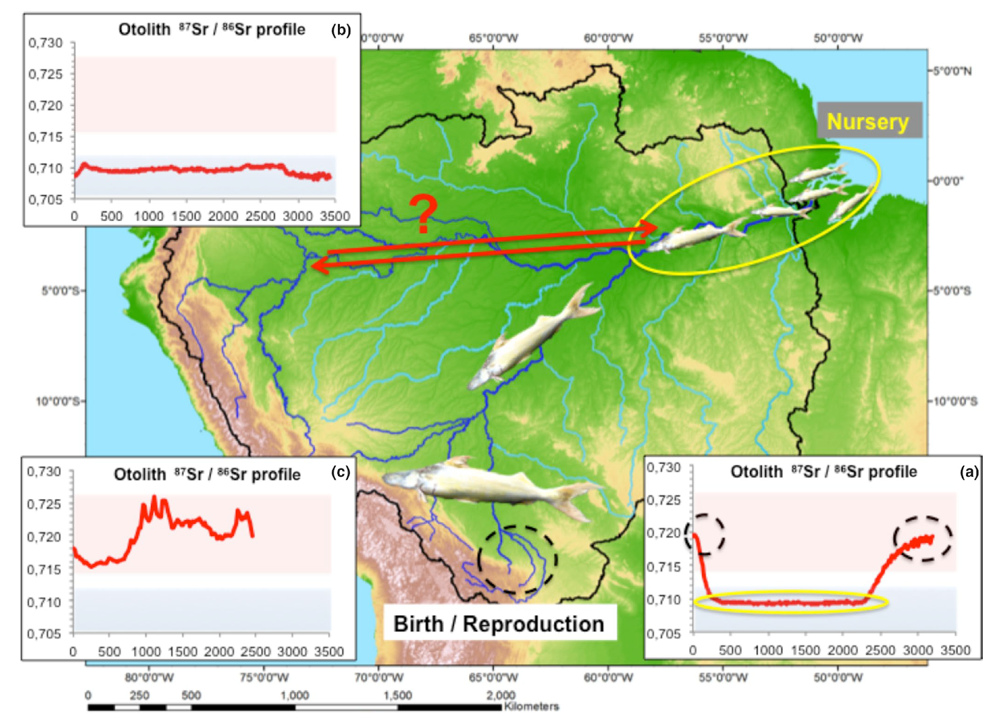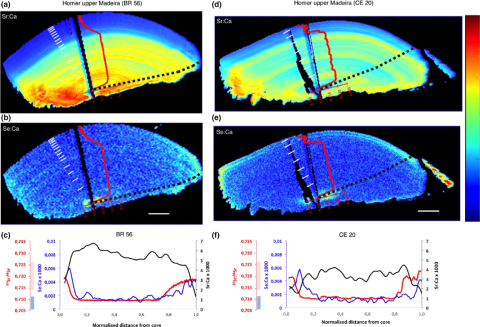What did the scientists discover?
The scientists demonstrated that the Amazonian goliath catfish B. rousseauxii has a complex life cycle, involving partial migration even in the absence of physical barriers, in the upper Amazon Basin. The researchers also made a methodological advance by establishing that synchrotron X-ray fluorescence microscopy (SXFM) can image elemental distributions of strontium, calcium, and selenium which provide information about fish life cycles consistent with and complementary to strontium isotope analysis.
Why is this important?
Adult fish that return to their place of hatching to reproduce are said to perform natal homing. Understanding the interactions between natal homing processes of fish in the Amazon Basin and the increasing presence of hydroelectric dams will have profound impacts on fishery management.

What are the broader impacts of this work?
These findings lay the groundwork for conservation efforts in the context of hydro-power development in the Amazon Basin and set testable hypotheses of the potential impacts of the Madeira River dams. The use of SXFM in this context enables researchers to understand more details of the individual fish life histories than was previously possible using isotope analysis alone.
Why did this research need CHESS?
SXFM was performed at the F3 beamline of CHESS, at 16.1 keV with a 30 µm spot delivering approximately 4x1010 photons per second. Mapping was performed with dwell times of 0.33-0.45 s per point, enabling screening of entire otoliths with suitably high trace element sensitivity. The high concentration of calcium in otoliths (fish ear bones) can make analysis of trace element composition difficult without the high X-ray photon flux available at CHESS.
Collaborators:
- Marília Hauser, Departamento de Biologia, Universidade Federal de Rondônia, Brazil.
- Fabrice Duponchelle, Institut de Recherche pour le Développement, France.
- Theodore W. Hermann, Department of Environmental and Forest Biology, SUNY-ESF, United States.
- Karin E. Limburg, Department of Environmental and Forest Biology, SUNY-ESF, United States.
- Leandro Castello, Department of Fish and Wildlife Conservation, Virginia Tech, United States.
- Donald J. Stewart, Department of Environmental and Forest Biology, SUNY-ESF, United States.
- Gislene Torrente‐Vilara, Universidade Federal de São Paulo, Brazil.
- Aurea García‐Vásquez, Programa AQUAREC, Instituto de Investigaciones de la Amazonía Peruana, Peru.
- Carmen García‐Davila, Laboratorio de Biología y Genética Molecular, Instituto de Investigaciones de la Amazonía Peruana, Peru.
- Marc Pouilly, Institut de Recherche pour le Développement, France.
- Christophe Pecheyran, French National Centre for Scientific Research, France.
- Emmanuel Ponzevera, Laboratoire Biogéochimie des Contaminants Métalliques, France.
- Jean‐François Renno, Institut de Recherche pour le Développement, France.
- Arthur S. Moret, Departamento de Física, Universidade Federal de Rondônia (UNIR), Brazil.
- Carolina R. C. Doria, Departamento de Ciências Biológicas, Universidade Federal de Rondônia (UNIR), Brazil.
Publication Citation:
M. Hauser et al., “Unmasking continental natal homing in goliath catfish from the upper Amazon,” Freshwater Biology 2020, 65, 2, 325-336 https://doi.org/10.1111/fwb.13427
How was the work funded?
The research was conducted at CHESS which was supported by the NSF under award DMR-1332208
